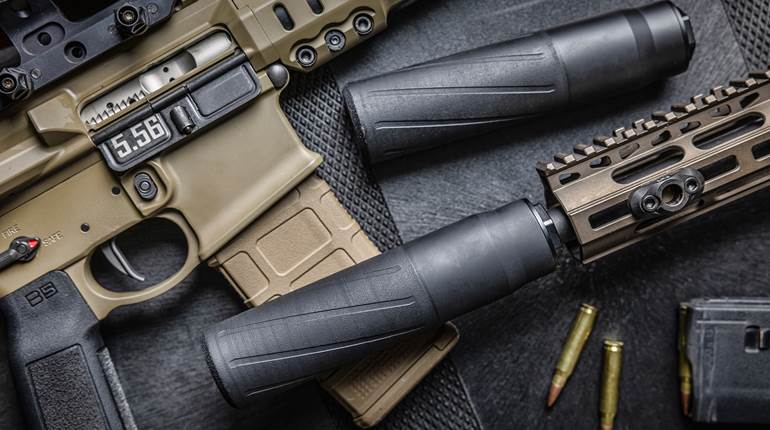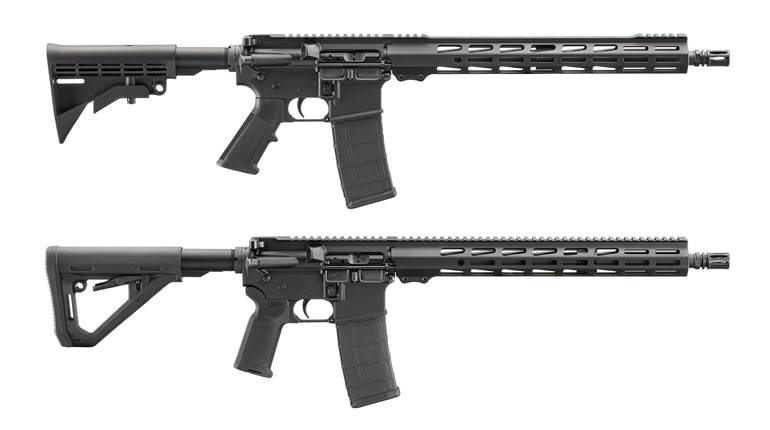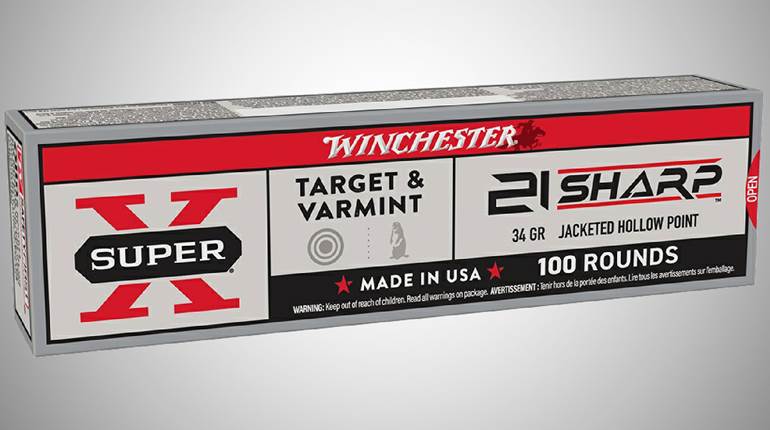
While some folks have written off the AR-15 pistol as nothing more than a range toy, others have chosen this semi-automatic pistol platform to serve as a primary or secondary defensive option. Although I've enjoyed shooting rifle-action pistols in a variety of configurations for some time now, I hadn’t really considered the possibility of staging one for personal protection until last year.
In January of 2015, I was examining a new AR pistol at SHOT Show when a well-known media personality and shooting instructor I know strolled up to the display and shook his head. In his opinion, AR pistols were utterly, totally and completely useless in every way. In short, he would rather fend off a home invasion with a brick than one of those things. It seems safe to say his comments qualify as a vote against it.
Months later, I received an unexpected response to a piece we posted about trunk guns. It was interesting to note the number of readers who chimed in to let me know that I had left their preferred trunk gun off the list, namely, the AR-15 pistol. On the one hand its critics’ pan the AR pistol as if it were a badly written big-budget Hollywood movie while fans of the platform are lining up for tickets.
I often find this kind of dichotomy of shooting community opinion intriguing because the truth of the matter often lies somewhere in between the two extremes. Rather than jump in with either AR pistol camp, I decided to find out for myself with a series of AR pistol builds and projects that would take the better part of a year to complete.
Before selecting any guns or components to work with, it was important to identify which test parameters would be employed for this particular write up. I set aside the roles of hunting, recreational shooting and defense outside the home to focus primarily on evaluating the AR-15 pistol as a home-defense option. Stopping a threat inside a residence usually means engaging them at contact distance (arms length), across the room (3 to 5 yards) or across a typical interior living space (10 to 18 yards). Therefore, formal accuracy testing would be conducted at 25 yards. Other home-defense issues to be kept in mind included ammunition capacity, ammunition performance and handling characteristics.
Going into this test I had the information gleaned from the Building AR-15 Pistols at Home project which focused on .223 Rem./5.56 NATO pistols. That experience left me with two important questions in regard to home defense. First, is there anything else that can be done to improve the pistol's ergonomics in place of restricted vertical grips and legally dubious wrist braces?
The other issue was pistol performance. The .223 Rem. and 5.56 NATO cartridge launch lightweight bullets at high velocity. However, when these cartridges are fired from pistol-length barrels, especially those under 10" in length, the bullets demonstrate a significant drop in speed and impact energy (which is another general complaint against AR-15 pistols). Could ammunition performance be improved by switching to larger AR-compatible calibers topped with heavier bullets?
To answer these questions I assembled a pistol lower with features suited to home-defense scenarios and paired it with two factory assembled gas-impingement uppers chambered in 300 BLK and 7.62x39 mm.

The 'HD' Custom Pistol Lower
The foundation of the “HD” pistol is an Adcor Defense milled billet lower fitted with an Anderson Manufacturing lower parts kit. I wanted a simple, no-frills set of controls that were utterly reliable. This included a smooth HiperFire Hipertouch EDT trigger group configured to 4 lbs. 7 oz. of trigger pull. In hopes of making the pistol more controllable, the smooth polymer A2 grip from the lower parts kit was replaced with the Ergo Grips Original grip with an aggressively textured soft-touch surface. This proved to be a good choice because the grip provides excellent purchase without being abrasive to bare skin.


The buffer assembly is the Thordsen Custom AR/AK Enhanced Pistol Cheek Rest Kit with a Mission First Tactical (MFT) saddle. The system incorporates the company's Enhanced Buffer Tube Cover kit with the MFT EVOLV Battle Stock Attachment mounted directly to a buffer tube at the factory. It provides a proper cheek weld for added stability and a proper sight alignment without a vertical extension that can be shouldered. This means it's not considered to be either a shoulder stock or a wrist brace so installing one does not change the legal status of an AR pistol. I found the Thordson system to be quite useful because it makes forming a proper sight picture a much faster and easier proposition than with typical buffer tube configurations.

The Ground Zero Precision (GZP) 9" Barrel .300 BLK Pistol Upper
The .300 AAC Blackout (300 BLK) cartridge, inspired by J.D. Jones' .300 Whisper wildcat cartridge, was designed to fire heavier .30-cal. bullets while maintaining cartridge dimensions compatible with 5.56/.223 AR-15 magazines and bolts. This cartridge is particularly interesting for AR pistols because of the two types of factory loads on the market. Supersonic rounds topped with bullets ranging from 110-gr. to 125-gr. can maintain velocities of around 2000 fps from barrels as short as 9" while subsonic rounds (designed for use with sound suppressors) push 220-gr. bullets at around 1000-fps. This choice of ammunition allows for a good deal of flexibility in tuning a pistol's performance.

The Ground Zero Precision Ballistic Advantage 300 BLK rifle upper tested for another article proved to be a top-notch option, so I requested the handy factory assembled pistol version for this set of tests. The threaded 4150 steel 9" Ballistic Advantage barrel has an A2 flash hider, 1:7” RH six-groove rifling, an M4 Feed Ramp and a QPQ corrosion resistant finish. The forged 7075-T6 flat top upper receiver is graced with both a forward assist and a dust cover.
The stainless steel pistol-length gas tube is connected to a low profile SLR Rifle Works Sentry adjustable gas block which comes in handy with the broad range of 300 BLK ammunition pressure levels. Other features include a GZP Extended Latch charging handle, GZP Tac-Hunter-7 Keymod free float handguard and the company's in house phosphate-finished, chrome lined Dead Bolt GEN II +P Premium M16 bolt carrier group (BCG).
It took a few rounds of supersonic and subsonic ammunition to find a gas block setting that was just right for both. Once it was properly tuned, this upper fed, fired and ejected without any problems using mil-spec and commercial magazines from Brownells, Magpul and Mission First Tactical (MFT).
The Hardened Arms 10.5" Barrel 7.62x39 mm Pistol Upper
The 7.62x39 mm cartridge, famously chambered by the ubiquitous AK-47 rifle, has external dimensions that are compatible with AR-15 platforms. Because this is such a popular cartridge here in the United States there are plenty of ammunition options to choose from ranging from inexpensive steel-cased surplus rounds up to premium new production hunting loads. Fired from standard length rifle barrels this cartridge pushes 0.312-caliber 123-gr. bullets at velocities around 2400-fps. I wanted to see how this round faired in shorter barrels because, if it held on to enough energy, it can be more affordable to practice with.

For this factory assembled upper I turned to Hardened Arms of Friday Harbor, Wash. Founded in 2012, this company specializes in mil-spec AR platforms and sound suppression systems. The 10.5" HBAR profile barrel features 1:10 RH six-groove rifling with a Melonite finish. The muzzle is threaded at 5/8x24 TPI and sports an A2 type flash hider. The forged 7075-T6 flat top upper receiver has a dust cover and forward assist. 
The carbine-length gas tube is paired with a low-profile gas block that fits comfortably under the 7" free-float Tac Quad Rail handguard. In addition to the optical top rail, this handguard has full-length rails at the 3-, 6- and 9-o'clock positions that were fitted with Ergo Grips Diamond Plate 15-slot rail covers. The black phosphate finished 7.62x39 mm BCG is chrome lined for increased durability.
Hardened Arms recommends Ammunition Storage Components (ASC) 7.62x39 mm magazines as the most reliable option to use with their platform. In addition to the 10-round magazine provided with the upper I ordered a few 20- and 30-round magazines directly from ASC. All of them fit tightly into place and fed reliably. Some ARs chambered for 7.62x39 mm have a reputation for being ammunition sensitive but the Hardened Arms upper ran smoothly and reliably with the ammunition tested.
At the Range
Before working with these two .30-cal. uppers, the AR pistols I had the most trigger time with were chambered for .223 Rem. They proved to be exceptionally loud with a bright muzzle flash in spite of the A2 flash hiders. This is a problem for home defense as it can leave the home defender deafened and temporarily blinded if they touch off a round in a confined space like a narrow hallway. Just about all AR pistols need to be fitted with some kind of gas forward/noise directing muzzle device and hearing protection (electronic muffs) should be staged with the gun. 
The supersonic 300 BLK and 7.62x39 mm loads were just as vocal as the .223 Rem. with the 7.62x39 mm taking home the trophy for brightest muzzle flash. Felt recoil ranged from moderate to relatively stout during off the bench shooting using a Sandstorm Custom single-point sling for added stability. However, the pistol was manageable using both uppers with a firm grip. Recoil and noise levels dropped significantly when firing subsonic 300 BLK rounds.

Formal accuracy testing consisted of 5-shot groups fired at 25 yards from a benchrest. Both uppers were sighted in and fired using a high-quality Leupold Deltapoint Pro 2.5 MOA red-dot optic attached to the flattop upper receivers using a Leupold Pro Cross Slot Mount. Bullet velocity was measured using a Lab Radar chronograph with a 12" offset from the muzzle.
The following table shows the performance results for two .223 Rem. pistols with different barrel lengths in addition to the results for the GZP and Hardended Arms uppers:

The GZP 9" 300 BLK upper produced impressive results despite having a barrel that's a full 7" shorter than a typical AR carbine. The tested loads maintained between 93 percent - 99 percent of the ammunition manufacturers’ listed rifle velocities with 88 percent to 97 percent of the listed rifle muzzle energy levels. The subsonic load yielded down range energy levels comparable to a .45 ACP pistol loaded with +P ammunition which makes it a viable option for close-quarters defense.
The Hardened Arms 10.5" 7.62x39 mm upper maintained between 87 percent to 91 percent of manufacturers’ listed velocities and 76 percent to 82 percent of the muzzle energy. Despite a slightly greater performance drop compared to the 300 BLK, muzzle energy still ranged from 1134 ft. lbs. to 1241 ft. lbs. which is roughly double the muzzle energy produced by a .357 Mag. revolver.

The 7.5" .223 Rem. upper demonstrated the greatest performance loss of the four test uppers with only 64 percent to 68 percent of listed muzzle velocity resulting in 41 percent to 47 percent of listed muzzle energy. The 10.5" .223 Rem. performed better with 75 percent to 78 percent of list velocity and 56 percent to 61 percent of listed muzzle energy.
I have no doubt that all four of these uppers would leave a distinct impression should they be employed to stop a threat at across-the-room distances. Based on these numbers, I can see why some folks seriously consider AR pistols as a defensive option. However, that being said, the .223 Rem./5.56 NATO pistols provide about half of the performance the cartridges were designed to produce when fired from a rifle. For home defense applications, the 300 BLK and 7.62x39 mm pistols provide a much more decisive level of performance. If it's important to reduce felt recoil, then 300 BLK loaded with subsonic rounds is the better option because the heavier 220-gr. bullets are traveling within their intended velocity range.
Lessons Learned
Gas-impingement-operated semi-automatic AR-15 pattern pistols provide most of the same advantages that accompany AR rifles and carbines. This includes a plentiful supply of aftermarket parts and upgrades, a reliable action, affordable caliber conversions and kits for home builders, potent caliber options and a familiar set of controls. The AR pistols’ bench-rested accuracy results at 25 yards are superior to many other types of handguns thanks to their longer barrels and useful sighting system options.
However, the lack of a shoulder stock and the legal restrictions against using vertical foregrips makes these rifle-action handguns unwieldy when compared to traditional handguns or long guns. The platform's relatively poor ergonomics can be significantly improved with the addition of unrestricted accessories including single-point slings, textured grips and buffer tube cheek pieces.
The platform’s ammunition capacity and caliber options are definitely effective. However, just like any other firearm type, repeatable accuracy in a defensive situation relies on the operator applying proper techniques that have been drilled in through training and practice. Pick any other personal protection platform on the market (pump-action shotguns, semi-auto rifles, revolvers, pistols) and it will be supported by dozens of resources to help gun owners understand how to run it correctly, including books, videos and live fire classes held around the country. Although trainers and training systems differ when it comes to minor points of etiquette, there is, on the whole, a core consensus of the right ways and the wrong ways to run that particular platform when fighting for your life.
The extensive range testing process I completed produced a useful set of information but I have yet to find any training courses or materials that teach folks how to fight with an AR-15 pistol. The instructors I have questioned so far on the subject say that they do not offer classes for this gun. They prefer to teach students to use AR-15 carbines and rifles or more traditional handguns.
Having worked regularly with this platform for several months now (without any outside assistance), I'd like to think that I've figured a few things out on my own. With the information I do have, would I stage an AR pistol for personal protection at this point? I'm much closer to saying yes to that question than ever before because the guns themselves are such impressive performers.
That being said, the lack of a well developed manual of arms leaves me without the means to confirm if my home-made approach to using this platform is tactically sound or not. Therefore, I'm going to have to hold off on giving the AR-15 pistol a thumbs-up as a home defense option until I learn more.
Specifications
Custom Pistol Lower Assembly (Home Build)
Lower Receiver: Adcor Defense Milled Billet Lower $249.99
Complete Lower Build Kit: Anderson Manufacturing (AM-556-LW-PARTS-KIT) $49.70
Trigger Group: HiperFire Hipertouch EDT $89
Trigger Pull: 4 lbs. 7 oz. (As Tested)
Grip: Ergo Grips Original with Aggressive Texture (4009) $28.50
Buffer Tube: Thordsen Custom AR/AK Enhanced Pistol Cheek Rest Kit with MFT Saddle (Black) $84.99
Buffer: Thordsen Custom AR-15 Carbine Buffer & Spring $26.94
Total MSRP: $529.12
Red Dot Sight: Leupold Deltapoint Pro 2.5 MOA Dot (#119688) $779.99
Optic Mount: Leupold Pro Cross Slot Mount (#120056) $109.99
Upper: Ground Zero Precision (GZP) Factory Assembled
Model: 9" Free Floated Ballistic Advantage 300 BLK (BA9TH73A)
Action: Gas-Impingement Semi-automatic
Caliber: 300 BLK
Upper Receiver: M4 Type Flat Top Forged 7075 T6 Aluminum
Ejection Port Cover: Yes
Forward Assist: Yes
Charging Handle: GZP Extended Latch Charging Handle
Complete Bolt Carrier Group (BCG): GZP Phosphate Dead Bolt GEN II +P Premium M16
Barrel: Ballistic Advantage 9" 4150 Steel, M4 Feed Ramp, QPQ Corrosion Resistant Finish
Rifling: 1:7 RH
Grooves: 6
Muzzle Threading: 5/8x24 TPI
Muzzle Device: A2 Flash Hider
Gas Block: .750" SLR Rifle Works Sentry Adjustable, Low Profile
Gas Tube: Pistol Length, Stainless Steel
Handguard: Ground Zero Precision 7" Free-Float Tac-Hunter-7 Keymod
Upper Length: 17.5"
Upper Weight: 3 lbs. 8 oz.
Complete Pistol Overall Length: 25.75"
Complete Pistol Weight: 5 lbs. 15 oz. Unloaded, No Magazine
Magazines: Mil Spec or Commercial 5.56 Magazines
Sights: None
MSRP: $554
GZP Firepower Extension for Magpul PMAGs: $46.50
Upper: Hardened Arms Factory Assembled
Model: 10.5" 7.62x39mm Melonite Upper Tac Quad Rail
Action: Gas-Impingement Semi-automatic
Caliber: 7.62x39 mm
Upper Receiver: Forged 7075 T6 Aluminum
Ejection Port Cover: Yes
Forward Assist: Yes
Charging Handle: Mil Spec
Complete Bolt Carrier Group (BCG): 7.62x39 mm Phosphate, Chrome Lined
Barrel: 10.5" HBAR Profile Barrel with M4 Extension, Black Melonite Finish
Rifling: 1:10 RH
Grooves: 6
Muzzle Threading: 5/8x24 TPI
Muzzle Device: A2 Flash Hider
Gas Block: .750" Low Profile
Gas Tube: Carbine Length
Handguard: 7" TAC-HUNTER Free-Float
Upper Length: 19.5"
Upper Weight: 4 lbs.
Complete Pistol Overall Length: 27.25"
Complete Pistol Weight: 6 lbs. 9 oz. Unloaded, No Magazine
Magazines: Ammunition Storage Components (ASC) 10-Round Provided
Sights: None
MSRP: $498.99 (As Tested)
Rail Covers: Ergo Grips Diamond Plate 15-Slot Rail Cover 3-Pack (4365-3PK-BK) $38.75























![Winchester Comm[94]](/media/1mleusmd/winchester-comm-94.jpg?anchor=center&mode=crop&width=770&height=430&rnd=134090756537800000&quality=60)
![Winchester Comm[94]](/media/1mleusmd/winchester-comm-94.jpg?anchor=center&mode=crop&width=150&height=150&rnd=134090756537800000&quality=60)












